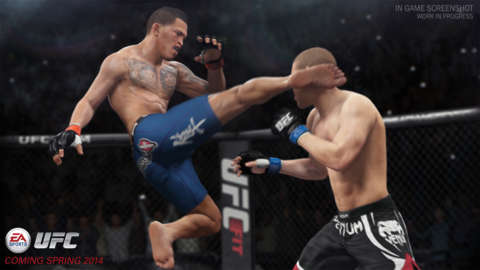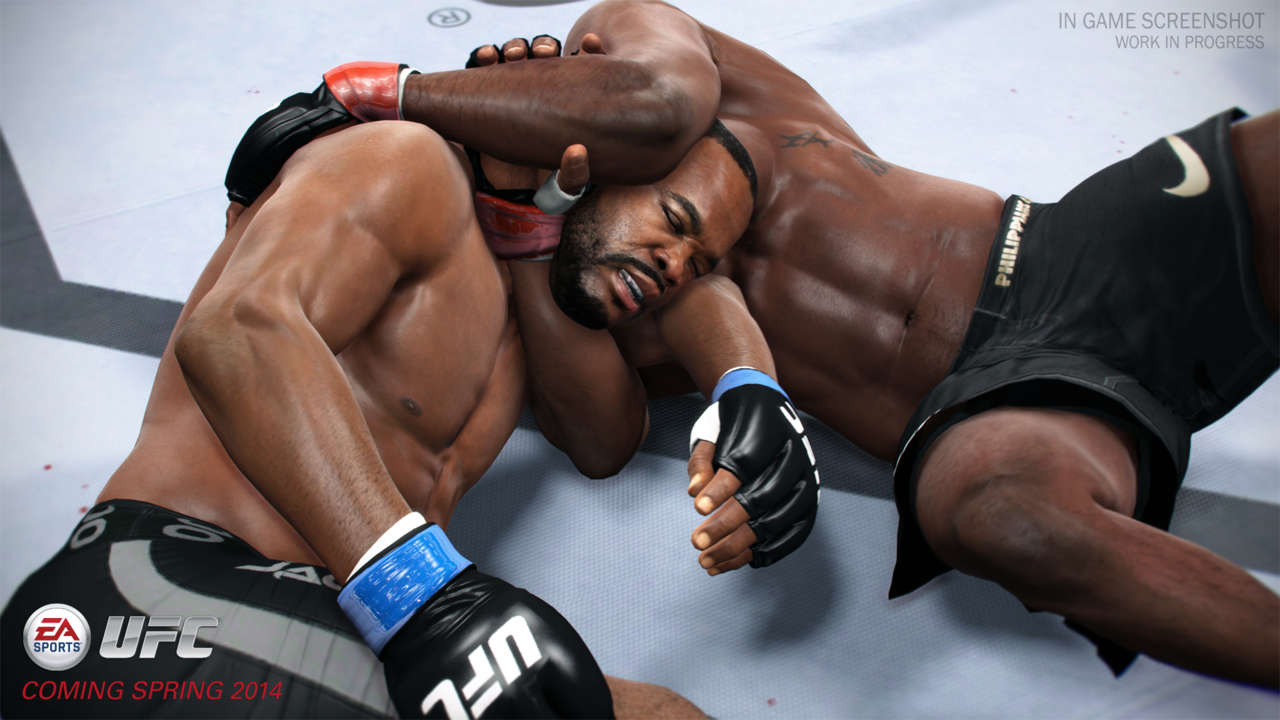EA Sports UFC: Gameplay vs Realism
Action abstraction.
No matter what the subject matter, there's a point at which most games with a grounding in realism must sacrifice said realism for the sake of gameplay or, to put it another way, find ways to improve upon realism. That's why bullets hurt only our health bars in shooters and why racing games rarely require us to refuel. It's also why in EA Sports UFC, which I had an opportunity to play for the first time recently, Career mode training minigames will award you development points rather than simply improve the fighter attributes that you might expect them to. It's one of seemingly very few ways that EA Sports UFC will deliberately ditch realism for the good of the game, and one of a few reasons why I'm more excited about EA Sports UFC now than I was a week ago.
As my Anthony Pettis approached the octagon to take on creative director Brian Hayes' Benson Henderson, it quickly became apparent that no realism is being sacrificed where EA Sports UFC's visuals are concerned. Immediately recognizable in-game athletes are nothing new, but the leap in quality here is akin to that achieved in Fight Night Round 3 back in 2006. Every licensed fighter in the game is purportedly being created using 3D head and body scans to ensure that that everything from their body proportions down to their tattoos are exactly right; judging by how good Pettis and Henderson looked, there's no reason to doubt that claim. They moved believably too, their illusion ably assisted by details like realistically bouncing pecs and individual toes that spread as weight shifted to them. I never would've noticed if Hayes hadn't pointed them out, but the fighters even had real-time reflections of the UFC arena on the corneas of their eyeballs.
Adding to EA Sports UFC's realism during my play session were numerous other characters that you'd expect to see during a UFC fight on TV. Big John McCarthy was inside the octagon refereeing, Mike Goldberg and Joe Rogan were among the folks sat ringside, three cornermen were present for each fighter, and octagon girls like Arianny Celeste were visible not only as they paraded between rounds but also while in their seats. Realism faltered a little when my Pettis lost to Hayes' Henderson given the two fighters' history (Pettis has defeated Henderson both times that they've fought), but we can chalk that one up to me not being entirely at ease with the controls despite them being reminiscent of those in UFC Undisputed 3.
One aspect of the controls that appears to have received a lot of attention is the submission game, which benefits from the fact that Hayes and his colleagues have been practising Brazilian jiu-jitsu. "The gameplay team up at EA Canada has actually been rolling in BJJ now for over a year and a half. We started doing that right after we signed the deal with UFC because, well there are some guys on the team who had been doing it prior to that, but we thought hey it'd be a great opportunity for the guys to get some firsthand experience and some insight into what the ground game is like. And it really did inform a lot of our design side objectives, so far as what we wanted to accomplish with our submission game," explained Hayes before offering up an anecdote about a colleague who is able to use BJJ effectively with his eyes closed because all of the information that he needs comes from feeling things like weight and balance. "So it was pretty challenging, how are you going to make a game about something that you can do with your eyes closed when you can only give people visual information? So we know that we're going to have to abstract things to some degree."

On this occasion, the abstraction of the submission game feels like an evolution of the system that THQ employed in UFC Undisputed 3. In that game, colored bars representing each fighter chased each other around the perimeter of an octagon shape; in EA Sports UFC a similar octagon graphic appears on the screen but the way that you interact with it is quite different. As the fighter being submitted, you attempt to escape by pushing out in one of four directions using the right analog stick while your opponent--also using the right analog stick--tries to stop you by pushing in the same directions. In order to advance whichever of the game's 29 submissions they're using to the next stage, your opponent must also move the left analog stick in the correct direction when prompted to do so, resetting any progress that you've made trying to escape in the process. It's really not as complicated as it sounds, and while obviously not realistic it's certainly analogous with a real submission attempt given that the fighter on the offensive has to concern themselves with controlling a struggling opponent as well as advancing his own position.
Similarly analogous with reality is the system that EA Sports UFC will employ to let you know when your Career mode fighter should hang up his gloves. Nothing of the new Career mode was being shown during our demo, but I asked Hayes about it because I remember being frustrated when the aging of my fighters in the UFC Undisputed games would send their stats into a steady decline. His reponse was music to my ears: "We don't have a your-ratings-get-crappy effect. What we do have is a health meter for your career. We call it a longevity meter."
The longevity meter will deplete not as a result of your created fighter's age but rather as a result of the damage that they inevitably sustain over the course of their career, which makes a lot of sense when you consider the wildly different ages at which MMA fighters choose to retire. So will getting beaten up a lot cause your attribute ratings to decline? Not according to Hayes: "It doesn't mean that if you only have a little left in the meter that all of your attributes suck or that you've totally lost all of your skill, it really just means that you're at a point where UFC doesn't think you should fight anymore."

Another consideration will be your fighter's popularity. "The idea is that if you're a fan favorite your longevity goes down a little more slowly because the UFC wants to keep you fighting longer." We didn't get to talk about the factors that will go into determining that popularity, but it seems reasonable to assume that winning fights with knockouts and submissions rather than decisions will play some part. Based on my experiences with THQ's UFC games I wondered if intentional illegal blows might make a fighter less popular with fans, but those actually won't be a feature of EA Sports UFC at all. In what's hopefully a triumph of gameplay being prioritized over realism, low blows have been cast aside so that unscrupulous online players can't use them to prematurely end fights that they're going to lose, thus depriving their opponent of a satisfying victory.
And what satisfying victories they promise to be. I'm looking forward to bringing my imaginatively named kickboxer, Justin Calvert, out of retirement when EA Sports UFC hits stores this Spring.
Got a news tip or want to contact us directly? Email news@gamespot.com
Join the conversation